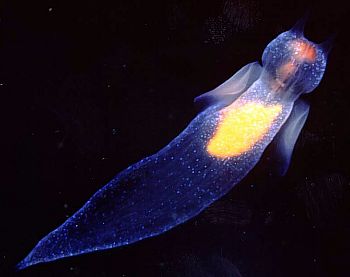
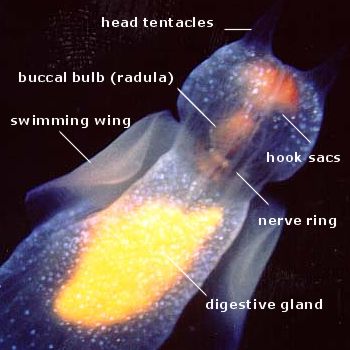
Clione limacina
(Phipps, 1774)
Order: GYMNOSOMATA
Suborder: GYMNOSOMATA
Family: Clionidae
DISTRIBUTION
Northern Hemisphere in polar and cold temperate waters - Pelagic
PHOTO
Quadra Island, near Campbell River, Vancouver Island, British Columbia, Canada. Photographed in 1999, just beneath the surface. PHOTO: Marli Wakeling.
Clione limacina is a relatively common non-shelled (gymnosomatous) pteropod and appears to feed exclusively on species of the shelled (thecosomatous) pteropod genus Spiratella. it grows to about 25mm in length. Lalli (1970) studied its feeding behaviour in laboratory studies, which showed how the unique feeding apparatus of these gymnosomatous pteropods functions.
When C. limacina makes contact with its prey it rapidly everts a set of six buccal cones, which are in fact eversible tentacles, which grab the shell of Spiratella and turn it around until its shell opening is facing the mouth of Clione. At this stage large chitinous hooks are everted from a pair of sacs, called hook sacs, and grasp the prey animal. It takes about 30 minutes for C. limacina to pull Spiratella out of its shell and to swallow it whole. At this point it drops the empty shell. Clione and Spiratella are well-known to fisheries biologists as common members of the plankton in fishing grounds. They are usually found associated with each other and as is usual in carnivore and herbivore prey relationships the ratio of prey to predator is very high, often reachng more than 500:1. Clione limacina is itself eaten by fish and sea birds.
Clione limacina was previously considered to have a bipolar distribution but Gilmer & Lalli (1990) show many internal and external differences between northern and southern hemisphere populations and consider the southern populations should be considered a distinct species, C. antarctica (Smith, 1902).
-
Gilmer, R.W. & Lalli, C.M. (1990) Bipolar variation in Clione, a gymnosomatous pteropod. Am. Malacol. Union Bull. 8(1): 67-75.
-
Hermans, C.O. & Satterlie, R.A. (1992) Fast-strike feeding behaviour in a pteropod mollusk, Clione limacina Phipps. Biol. Bull., 182: 1-7.
-
Lalli, C.M. (1970) Structure and functioning of the Buccal Apparatus of Clione limacina (Phipps) with a review of feeding in gymnosomatous pteropods. Journal of experimental marine Biology and Ecology, 4: 101-118.
-
Lalli, C.M. & Gilmer, R.W. (1989) Pelagic Snails. The biology of holoplanktonic gastropod molluscs. Stanford University Press: Stanford, California.
-
Morton, J.E. (1958): Observations on the gymnosomatous pteropod Clione limacina (Phipps). Journal of the Marine Biological Association, United Kingdom, 37: 287-297.
Rudman, W.B., 2001 (May 14) Clione limacina (Phipps, 1774). [In] Sea Slug Forum. Australian Museum, Sydney. Available from http://www.seaslugforum.net/find/cliolima
Related messages
Re: Clione limacina in Greenland
November 26, 2007
From: Andy Murray
Concerning message #21108:
Thanks again for your reply, and you have no need to apologize, you're a great help.
I guess I wasn't very clear in my description, the snails I was describing were under water, the ice foot is the shore fast bit of ice in the intertidal zone. On the day in question it extended about 1.5 metres below the water surface, and the snails were landing on it anywhere from just below the surface to the bottom.
Take care,
Andy Murray
andyandmelanie@hotmail.com
Murray, A., 2007 (Nov 26) Re: Clione limacina in Greenland. [Message in] Sea Slug Forum. Australian Museum, Sydney. Available from http://www.seaslugforum.net/find/21127Thanks Andy,
Sounds very cold. I guess it is possible they could scrape the algal film - if there is one, off the ice, but I think we will have to wait for some intrepid biologist - or graduate student - to have a look
Best wishes,
Bill Rudman
Re: Clione limacina in Greenland
November 12, 2007
From: Andy Murray
Concerning message #20716:
Thanks again for this great forum, and for your quick reply, Dr. Rudman. I finally got my hands on Pelagic Snails, and have just begun looking at it.
Based on the pictures and description in the book I think you are right about the mystery sacs being the feeding webs of the sea butterflies. I wonder about your theory of the kayaks scaring them into abandoning their webs, certainly I saw exponentially more of the sacs than the snails. I never saw one with it's web, which is why I didn't see any connection at the time. If I get back up there I'll have to observe more carefully. I wonder how much of an energy cost it is for the snail to abandon it's web?
I said before that I thought the sea butterflies were Limacina retroversa, but I only came to that conclusion through an email correspondence with another biologist. I could never actually find a picture until now. Upon seeing the pictures in the book I don't believe that was correct. L. helicina looks much closer, but still not quite right. The shell looks about right, in terms of size and shape, but the wings had serrated tips, giving a "feathery" appearance. I know there's no Peterson field guide to pelagic pteropods, but I wonder if you have any suggestions as to how I could get a better id?
One other question I have about the sea butterflies is; do you know if the mucous sac is the only way they feed? The first time I saw them, on the ice foot near Clyde River (Baffin Island) in Nov., they were periodically "landing" on the ice and crawling around on it like a benthic snail. I assumed at the time that they were grazing.
Thanks again, and take care,
Andy Murray
andyandmelanie@hotmail.com
Murray, A., 2007 (Nov 12) Re: Clione limacina in Greenland. [Message in] Sea Slug Forum. Australian Museum, Sydney. Available from http://www.seaslugforum.net/find/21108Dear Andy,
I'm sorry I cant suggest an easy way to identify thecosome pteropod species. I'm afraid most are identified from their shells and we still have much to learn about the living animals.
Concerning your observation of them beaching themsleves on the ice - I would suspect this is an accident and their 'crawling around' is just their attempts to get back in the water. But then again I coud be wrong.
Sorry I cant be of much help
Best wishes,
Bill Rudman
Pteropods from New Jersey, USA
October 3, 2007
From: Kate Winters

Hello,
We found these creatures washed up on the (USA) New Jersey shore (Long Island beach) by the thousands last summer, 2006. These little guys were around an inch 1/2 long, transparent, with orange "guts" , fins, tail, and maybe a mouth. They looked like little manatee's.
Wondering if you can tell us what they are? Some experts are saying sea slugs.
Thank you - looking forward to your response,
Kate Winters and sons, Aaron and Jordan (age 12)
KFWinters@aol.com
Winters, K., 2007 (Oct 3) Pteropods from New Jersey, USA. [Message in] Sea Slug Forum. Australian Museum, Sydney. Available from http://www.seaslugforum.net/find/20879Dear Kate,
These are indeed sea slugs, and are commonly known as sea butterflies or pteropods. I am pretty sure your animals are the unshelled carnivorous pteropod Clione limacina, which feeds on another group of pteropods which still have a shell, and feed on microscopic plants in the plankton. If you have a look at the Fact Sheet for that species, and the messages attached to that page you will find more photos and information on the species.
Best wishes,
Bill Rudman
Clione limacina in Greenland
September 14, 2007
From: Andy Murray
Hello:
I am thrilled to find your forum. I am a sea kayak guide, and in Aug. 2007 I was fortunate to find myself guiding in the fiords around Qaanaaq, Greenland. It probably isn't a great news flash to you, but I saw thousands of Clione limacina while paddling there. I also saw quite a few sea butterflies, which I believe were Limacina retroversa. It sounds like the latter would probably be food for the former.
Locality: Qaanaaq, Surface, Greenland, Baffin Bay, August 2007, Surface near shore, and mid fiord. Length: 2-3 cms.
Another thing I was seeing a lot were clear sacks about the size of a chicken egg. They were very ephemeral, and would disintegrate upon being touched by a paddle or a finger. About the only thing that made them visible would be tiny bits of debris attached to them. I am wondering if they would be created by one of these creatures, or if you have any idea what they could be. There were literally thousands of them in the water.
I used to see the same sea butterflies on Baffin Island when I used to live in Clyde River, but I never saw Clione limacina there. Interestingly, I live in Tofino, British Columbia, and while I have guided year round for 7 years here, I have never seen anything like this. I wonder if there's something they like about the east coast of Vancouver Island that they don't get here on the west coast.
Thanks again for your forum, I look forward to any light you can shed on the mystery sacks.
Andy Murray
andyandmelanie@hotmail.com
Murray, A., 2007 (Sep 14) Clione limacina in Greenland. [Message in] Sea Slug Forum. Australian Museum, Sydney. Available from http://www.seaslugforum.net/find/20716Dear Andy,
I'll leave your query about 'sea butterflies' in the Washington-British Columbia area to one of our resident experts, but I was fascinated by your description of the mystery 'ephemeral clear sacs'. Of course they could be lots of things, but my first thought was the mucus feeding webs of thecosome pteropods like Limacina retroversa. There are some published papers on the topic but the best overall account is found in Lalli & Gilmer's book Pelagic Snails which I recently reviewed.
These pteropds produce a large mucus bubble, often many times the size of their body, in the case of Limacina helicina it can be 55 mm in diameter and in some species of Cavolinia over 100 mm. The animals 'hang' in the water with these feeding bubbles extended, gradually sinking as the web traps both phytoplankton and zooplankton. Usually the web is ingested, but I guess if the animals are disturbed - by a flotilla of kayaks perhaps - they could release the web as an escape response.
I might be quite wrong but at least it gives me a chance to mention the amazing feeding webs of the sea butterflies
Best wishes,
Bill Rudman
Re: Clione limacina from Newfoundland, Canada
June 27, 2007
From: Rob Freyer
Concerning message #20012:
Greetings,
Stumbled across this site while trying to gain knowledge on gymnosomes for an invert class. I was fortunate enough to encounter numerous Clione on a recent NSF cruise out in the Bering Sea. We were collecting zooplankton samples via bongo tows both in and out of the ice pack. After looking at copepods and chaetognaths these beauties really catch ones eye. Very cool!
Could have helped Josh out with locating samples for his study.
Also wondering, with increasing ocean acidification directly impacting species like Limacina, how will this impact Clione diets?
Thanks for the site Bill,
Rob
Seattle, WA, USA.
freyer@u.washington.edu
Freyer, R.N., 2007 (Jun 27) Re: Clione limacina from Newfoundland, Canada. [Message in] Sea Slug Forum. Australian Museum, Sydney. Available from http://www.seaslugforum.net/find/20074Clione limacina from Newfoundland, Canada
June 21, 2007
From: Ryan Murphy
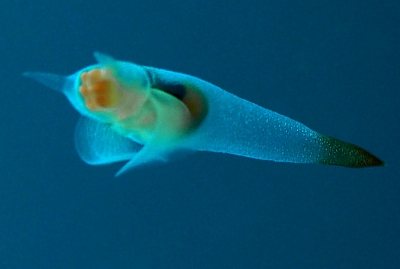
Concerning message #10308:
Hi Bill,
Managed to capture some Clione pics on Sunday, our waters here in Newfoundland are full of macrozooplankton this time of year. I have seen video of Clione limacina in local waters, but these were the first I've seen up close and personal. What a pleasure to swim with, they do loop-de-loops, slowly flapping their 'wings' and gracefully making all sort of twists and turns.
Locality: Tapper's Cove, Torbay, 0-10 m, Newfoundland, Canada, Northwest Atlantic, 10 June 2007. Length: Ranged from 1-5 cm. Photographer: R. Murphy.
Ryan Murphy
Ocean Sciences Centre
Logy Bay, NL
Canada
rmmrphy@mta.ca

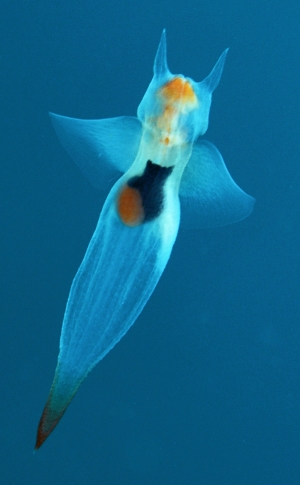
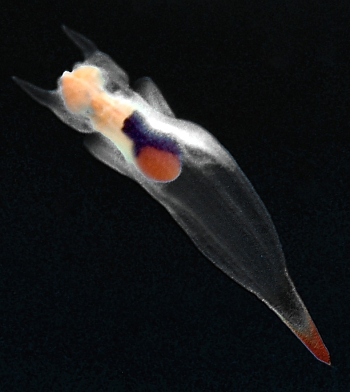
Thanks Ryan,
They are fascinating animals and despite occurring in vast numbers at times we have much to learn about their biology and ecology.
Best wishes,
Bill Rudman
Does Clione limacina have eyes?
December 12, 2006
From: Sim Kah Chine
Concerning message #4372:
My niece saw Clione limacina at Singapore Underwater World. She would like to know do Clione limacina has eyes? Or else how it sees?
Thanks!
Sim Kah Chine
shenjiaqing@yahoo.com
Shenjiaqing, 2006 (Dec 12) Does Clione limacina have eyes?. [Message in] Sea Slug Forum. Australian Museum, Sydney. Available from http://www.seaslugforum.net/find/18905Dear Kah Chine,
Your niece has asked a good question. Most sea slugs have eyes [see nudibranch head page and Sea Hare head pages] but the are not good enough for the slugs to be able to see anything with them. In the group of animals that snails and slugs belong to - the molluscs - only the cephalopods (squid, octopus) have eyes which can form images.
In fact none of the group of pteropods [Gymosomata] to which Clione belongs are thought to have eyes. If you look at the Clione limacina Fact Sheet you will see a pair of head tentacles. Many related species have a second pair of very small head tentacles at the back of the head, which have a group of nerve cells at the tips. Some people think these nerve cells may be a very primitive eye, but if so, I am sure it can't see anything.
Clione, like all pteropods relies on its very good sense of touch and smell to catch its food and find a partner.
Best wishes,
Bill Rudman
Clione limacina - how to keep alive?
April 14, 2005
From: Julie Lim
Dear List,
Hi, I am marine biologist of Underwater World Singapore. I'm assigned a task to exhibit Clione limacina. Anyone have any information regarding Clione's husbandry, tank design, flow pattern & etc.....
Thanks.
Julie Lim
JulieLim@uws.hawpar.com
Lim P. L., 2005 (Apr 14) Clione limacina - how to keep alive?. [Message in] Sea Slug Forum. Australian Museum, Sydney. Available from http://www.seaslugforum.net/find/13417Clione limacina from Quebec, Canada
June 25, 2003
From: Chantal Croteau
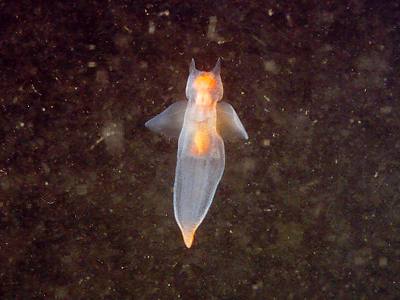
Dear Dr. Bill Rudman,
How amazed I was to find your web site! And to discover our little sea butterfly is widespread from Antarctica to Japan!!! (sorry for my English ... but I am very pleased to have the chance to share with you my story)
I am a diver who loves to visit the cold water of the province of Quebec, Canada. I was lucky to see my first Clione limacina at the Escoumins, in the St. Lawrence River (with the Labrador Stream and not the Gulf Stream - yes... cold sea water).
Somes identification guides revealed that whales includes this little pteropod in their food list (is it possible?). Clione limacina is wonderful and very gracious to see in the wild. I was very honored to look at this little pteropod in action, to swim in the cold water ... like flying in the sky! It is amazing!!! I was surprised to read that some people have tried to keep Clione in captivity? They can??? Or instead, they are able to keep them alive? wow...
Here, a picture taken at Escoumins, Canada, by Guy Lafond (my husband) in June 1996.
Thank you very much!
Chantal Croteau
cold water diver
guy.lafond@videotron.ca
Croteau, C., 2003 (Jun 25) Clione limacina from Quebec, Canada. [Message in] Sea Slug Forum. Australian Museum, Sydney. Available from http://www.seaslugforum.net/find/10308
Note added 20 June 2007: Carol Lalli has informed me that the excellent book Lalli & Gilmer (1989) is still available from Stanford University Press.
Dear Chantal,
Thanks for your message and the photo. Pteropods are indeed fascinating animals. If you an get hold of a copy of Lalli & Gilmer's book, which I think is unfortunately out of print, it has lots of information on the biology of the pteropods. Concerning where they live, in an earlier message I mentioned that we now think that the southern hemisphere populations are probably a separate species, but Clione limacina is still considered to be found all around the polar regions and northern temperate waters. Like you, it likes the cooler waters. Some whales certainly eat pteropods, but I don't think they pick and choose particular species. Baleen whales, such as the right whale, blue whale, and humpback, are plankton feeders, straining great quantities of microscopic animals with every mouthful of water.
Thanks again for sharing with us your photo and observations
• Lalli, C.M. & Gilmer, R.W. (1989) Pelagic Snails. The biology of holoplanktonic gastropod molluscs. Stanford University Press: Stanford, California.
Best wishes,
Bill Rudman
Bipolar distribution of Clione and Limacina
May 2, 2003
From: Yasuhiko Ito
Let me send a question from Tokyo, Japan. It is great to for me to find your special web site! I went to Antarctica (Commonwealth Bay) and dived few month ago. And we saw many Clione under the ice. It is identified as Clione antarctica according to the list by Nobert Wu etc. However, someone says it is same species as C. limacina of northern hemisphere. How do you think if they are same or different species? Also I would like to know the reason why Clione sp. and Limacina sp. are distributed in both the north and south polar regions? Has anyone ever checked DNA of those species?
I really want to know the reason of these bipolar distribution.
Yasuhiko Ito
ito@gentv.co.jp
Dear Yasuhiko,
It must have been an interesting adventure - if rather cold - diving in Antarctica. If you have any photos you would like to share they would be very welcome.
Concerning your question about pteropod distribution. One major problem with any interpretation of pteropod distributions is not being sure how to define a species? For example, if you have animals with long spines and others with short spines, are they an example of clinal variation within one species caused by physical parameters such as water temperature or salinity, or are they a genetic differences suggesting different species? We still have much to learn. Certainly the more traditional view of Clione is that there is one bipolar species. Van der Spoel (1967) has a long discussion on the various hypotheses explaining how bipolar distributions may have evolved through the affects of climate change, tectonic plate movement, leading to relict populations etc. Some of these factors most probably were involved in developing the two disjunct populations at either end of the world, but just because the populations may have arisen from the same parent population, that is no reason to consider them to still be a single species. After all, isolating factors are one of the mechanisms which bring about speciation. Gilmer & Lalli (1990) studied the anatomy of animals from both populations and from their anatomical studies, concluded that there were sufficient differences to justify considering the southern hemisphere population to be a distinct species, Clione antarctica (Smith, 1902).
• Gilmer, R.W. & Lalli, C.M. (1990) Bipolar variation in Clione, a gymnosomatous pteropod. Am. Malacol. Union Bull. 8(1): 67-75.
• van der Spoel, S. (1967) i>Euthecosomata. a group with remarkable developmental stages (Gastropoda, Pteropoda). J.Noorduijn en Zoon N.V.: Gorinchem, Netherlands.
Best wishes,
Bill Rudman
What should we feed Clione?
March 28, 2003
From: S. Kumagai
Hello!
I live in western Japan. My friend obtained a few Clione from Hokkaido, northern Japan, and is keeping them in an aquaria kept in his refrigerator. What should we feed his Clione? We are far away from Hokkaido and are not able to get shelled pteropods.
S. Kumagai
skumagai@ma.akari.ne.jp
Kumagai, S., 2003 (Mar 28) What should we feed Clione?. [Message in] Sea Slug Forum. Australian Museum, Sydney. Available from http://www.seaslugforum.net/find/9516Dear Mr Kumagai,
Most sea slugs, especially the carnivores, are fairly specific in their food requirements and we don't have alternative 'artificial' foods for them. As I say in the Clione limacina Fact Sheet, it seems that that species feeds only on species of the pteropod genus Spiratella. I'm afraid it is not always simple keeping opisthobranchs in captivity and I suspect pelagic pteropods would be among the most difficult.
Best wishes,
Bill Rudman
Clione do exist!
March 2, 2003
From: Paul Dymond
Hi there,
Just wanted to send you a message from up here in sunny Cairns. I've spent some time living in Hokkaido and seen Clione in aquariums and was talking about them here in the office and nobody believed that they existed so it was great to find your page!
Regards
Paul Dymond
Japanese Medical Services
Cairns
japmedical@bigpond.com
Dymond, P., 2003 (Mar 2) Clione do exist!. [Message in] Sea Slug Forum. Australian Museum, Sydney. Available from http://www.seaslugforum.net/find/9283Thanks Paul,
The life of a prophet is never easy! I am glad we could help show you tell the truth. Keep on spreading the word.
Bill Rudman
Re: Where do I find Clione limacina?
May 19, 2001
From: Marli Wakeling

Concerning Josh Rosenthal's request for information, you can find Clione limacina during the summer months in the waters of British Columbia, Canada. They were exceptionally prevalent during the El Nino summer several years ago. The most reliable place that I have seen them is at Quadra Island, near Campbell River on Vancouver Island. This specimen was taken there in 1999, just under the surface.
Marli Wakeling
scubamarli@excite.com
Wakeling, M., 2001 (May 19) Re: Where do I find Clione limacina?. [Message in] Sea Slug Forum. Australian Museum, Sydney. Available from http://www.seaslugforum.net/find/4372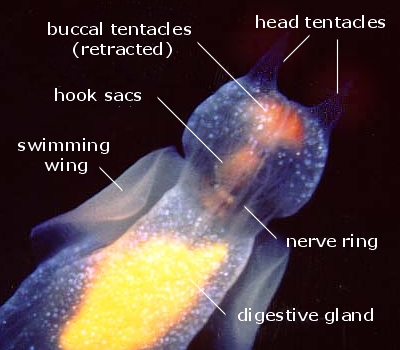
[Note added 20 June 2007: On the suggestion of Carol Lalli, an expert on these animals, I have changed the labels concerning the buccal organs].
Dear Marli,
Thanks for the wonderful photo. The pelagic opisthobranchs are fascinating animals. They are sometimes called sea butterflies for obvious reasons. I have labelled an enlarged version of the front end to show some of its distinctive features. Limacina and related gymnosomatous pteropods are voracious hunters feeding almost exclusively on their cousins the thecosomatous or shelled pteropods. Their buccal apparatus includes extensile buccal tentacles that are used to capture the prey, and hooks surrounding the radular teeth to drag it into the mouth.
Best wishes,
Bill Rudman
Where do I find Clione limacina?
May 15, 2001
From: Josh Rosenthal
Hello,
I'm a neurophysiologist at UCLA [California]and am doing a project comparing neuromuscular control of locomotion between similar species of Clione. Does anyone know an easy place to collect Clione limacina in abundance? I've tried at Friday Harbour Labs in Washington State and have found few animals after many, many hours of effort. Clione antarctica, by comparison, is simple at McMurdo Station [Antarctica].
Josh Rosenthal
chipotle@UCLA.edu
Rosenthal, J., 2001 (May 15) Where do I find Clione limacina?. [Message in] Sea Slug Forum. Australian Museum, Sydney. Available from http://www.seaslugforum.net/find/4335Dear Josh,
Hopefully someone will be able to give you some local knowledge. If you have any background information on these fascinating animals and their locomotion [or photos] it would be a welcome addition to the Forum
Best wishes,
Bill Rudman
